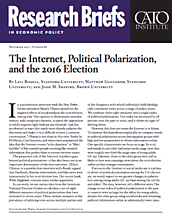In a postelection interview with the New Yorker, former president Barack Obama opined on the negative effects of social media in the 2016 election, stating that “the capacity to disseminate misinformation, wild conspiracy theories, to paint the opposition in wildly negative light without any rebuttal — that has accelerated in ways that much more sharply polarize the electorate and make it very difficult to have a common conversation.” Obama is not alone in this view. Books by Eli Pariser, Cass Sunstein, and others have popularized the idea that the Internet creates “echo chambers” or “filter bubbles” of like-minded people receiving like-minded information that pushes them to a more extreme stance.
The purported role of the Internet in politics goes beyond political polarization — it has also been cast as an important determinant of election outcomes. Hillary Clinton, in a postelection interview with Recode, argued that Facebook, Russian intervention, and fake news were instrumental in her 2016 election loss. Her recent book, What Happened, contains many similar arguments.
In our work, we use survey data from the American National Election Studies to calculate a set of eight different measures of political polarization that have increased in recent years. These include measures of the prevalence of splitting votes across multiple parties and of the frequency with which individuals hold ideologically consistent views across a range of policy issues. We combine these eight measures into a single index of political polarization. Our index has increased by 28 percent over the past 20 years, and it shows no signs of slowing down.
However, this does not mean the Internet is to blame. To examine this hypothesis empirically, we compare trends in political polarization across demographic groups with high and low propensities to obtain information online. One specific characteristic we focus on is age. In 2016, individuals 65 and older had social media usage rates that were roughly one-third the usage rates of young adults (18–39). Likewise, those in the older group were half as likely to have seen campaign news about the 2016 election online as their younger counterparts.
If access to the Internet or social media use is a primary driver of political polarization among the U.S. electorate, we would expect to see greater changes in polarization among young adults (18–39) than among the old (65 and older). The data, however, tell a different story. The change in our index of political polarization in the past 20 years is twice as large for the old as for young adults, despite the older group using social media and obtaining political information online at substantially lower rates.
These results are robust to restricting the analysis to party affiliates or individuals that express interest in the upcoming election. We also break down trends by cohort instead of age group and find that the oldest cohort has experienced larger changes in polarization than the youngest cohort. These findings are not unique to the index; seven of the eight individual polarization measures also display larger changes for the old (65 and older) than for young adults (18–39).
When computing a measure of predicted Internet access that takes into account the role of other demographics such as education and race in determining Internet access, we reach a similar conclusion. Individuals who were least likely to have had Internet access displayed greater increases in political polarization over the past 20 years than individuals who were most likely to have had Internet access.
We use the same data and employ a similar methodology to examine the claim that the Internet was instrumental in shaping the 2016 election outcome. Specifically, we compare trends in the Republican presidential vote share across three demographic groupings: between individuals with low and high predicted Internet access; between Internet users and nonusers; and between individuals who observed election information online and those who did not. We find no support for the hypothesis that the Internet was instrumental in determining the 2016 election outcome. Across all three comparisons, we find that Trump did as well as or better than his Republican predecessors among the low Internet groups and as well or worse among the high Internet groups. The 2016 election was the first time that the Republican vote share among the low Internet group was equal to or larger than that among the high Internet group for two of the measures.
These findings are difficult to square with the popular narratives that blame the Internet for political polarization and the rise of a populist president. However, they do not rule them out completely. Trump might have performed more poorly among Internet users absent the technology. It could also be that the Internet has a heterogeneous impact on polarization across age groups, making older individuals substantially more impacted than younger ones. Alternatively, polarization of young adults may have a spillover effect on older adults. This could arise directly via social spillovers or indirectly as polarization of the young causes media outlets or politicians to take more extreme positions. Allowing for these effects increases the potential role of the Internet in explaining recent trends in political polarization, but the amount of heterogeneity and spillovers would need to be quite large, relative to the direct effect, in order for the Internet to be the primary driver. While blaming the Internet for political events or trends may be tempting, we think the data suggest looking elsewhere for root causes.
NOTE:
This research brief is based on Levi Boxell, Matthew Gentzkow, and Jesse M. Shapiro, “Greater Internet Use is Not Associated with Faster Growth in Political Polarization among U.S. Demographic Groups,” Proceedings of the National Academy of Sciences, 2017, 114 (40), http://www.pnas.org/content/114/40/10612.abstract; and Levi Boxell, Matthew Gentzkow, and Jesse M. Shapiro, “A Note on Internet Use and the 2016 Election Outcome,” working paper, Stanford University, September 2017, http://web.stanford.edu/~gentzkow/research/trump-note.pdf.
About the Authors

This work is licensed under a Creative Commons Attribution-NonCommercial-ShareAlike 4.0 International License.
